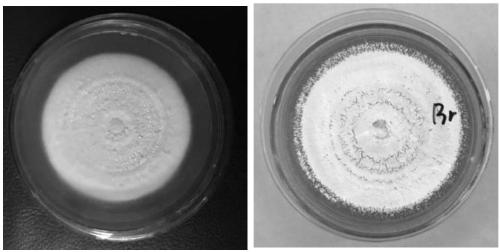Beauveria brongniartii BRNS50206 and application thereof
A technology of Beauveria bassiana and biological fungicides, applied in the field of agricultural biology, can solve problems such as environmental pollution and ecological damage, and achieve good control effects
- Summary
- Abstract
- Description
- Claims
- Application Information
AI Technical Summary
Problems solved by technology
Method used
Image
Examples
Embodiment 1
[0031] Example 1 Obtaining Beauveria bassiana
[0032] 1. Obtain high-efficiency strains
[0033] The present invention collects the dead insects infected with Beauveria from Shandong, Jiangsu, Hebei, Yunnan, Sichuan, Beijing, Inner Mongolia, etc., and separates and purifies the microorganisms in the laboratory.
[0034] Carefully pick the bacteria from the dead insects, inoculate them on the selective medium, and cultivate them at 25°C for 7 days, distinguish the colonies and transfer them to a new plate of selective medium, and cultivate them at 25°C for more than 14 days , after the colony is completely sporulated, it is transferred to a strain medium test tube, cultivated at a temperature of 25°C for 14 days, and stored in a refrigerator at 4°C.
[0035] The purified 63 bacterial strains were used for bioassay on the larvae of the black beetle. The specific method steps were as follows: the spores of each bacterial strain were mixed evenly with the soil, so that each gram...
Embodiment 2
[0042] The culture method of embodiment 2 bacterial strains
[0043] The culture method of bacterial strain of the present invention comprises the following steps:
[0044] (1) Liquid seed culture: the medium contains 3% sucrose, 1% peptone, 0.25% yeast extract powder, 0.01% magnesium sulfate, and the balance is water. Inoculate the spores of the test tube bacteria into the shake flask with the culture medium, the inoculation amount is 5×10 4 Spores / mL, shaking culture on a shaker at 25±1°C, 200rpm for 48h;
[0045] (2) Liquid secondary culture: the medium contains 2% sucrose, 1% soluble starch, 1% brewer's yeast, 0.4-0.6% dry carrot powder, 0.1% dipotassium hydrogen phosphate, 0.05% magnesium sulfate, and the balance is water. The liquid seed is inoculated into the fermenter, the inoculum amount is 3-5% according to the volume ratio, the temperature is controlled at 25±1° C., the rotation speed is 50-200 rpm, the ventilation rate is 0.5-0.8, and the fermentation is cultivat...
Embodiment 3
[0047] Example 3 Verification of the insecticidal ability of bacterial strains
[0048] 1. Verify the insecticidal ability of the strain spore powder
[0049] (1) The ability to kill scarab larvae
[0050] Add the spore powder obtained from the fermentation culture into the soil quantitatively, mix evenly, and form 1×10 per gram of soil 7 , 5×10 7 , 10×10 7 Different concentrations of spores were mixed with bacterial soil, divided into small plastic feeding boxes, and 1 grub caught in the wild was placed in each box, and potato pieces were added as feed. 20 grubs were treated at each concentration, repeated 3 times, and no bacteria powder was added. The blank soil was used as the control, cultivated at 23-26°C for 20 days, checked every 3 days, and determined the effect of the strain according to the comparison of the final mortality of grubs. In the experiment, it was observed that the dead worms became stiff, and the dead worms were transferred to a clean petri dish to k...
PUM
 Login to View More
Login to View More Abstract
Description
Claims
Application Information
 Login to View More
Login to View More - R&D
- Intellectual Property
- Life Sciences
- Materials
- Tech Scout
- Unparalleled Data Quality
- Higher Quality Content
- 60% Fewer Hallucinations
Browse by: Latest US Patents, China's latest patents, Technical Efficacy Thesaurus, Application Domain, Technology Topic, Popular Technical Reports.
© 2025 PatSnap. All rights reserved.Legal|Privacy policy|Modern Slavery Act Transparency Statement|Sitemap|About US| Contact US: help@patsnap.com



